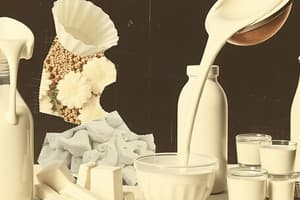Podcast
Questions and Answers
Which of the following best describes the role of heating milk to approximately 85°C in yogurt production?
Which of the following best describes the role of heating milk to approximately 85°C in yogurt production?
- It ensures the lactose is completely broken down before bacterial culture is added.
- It inhibits the growth of any unwanted bacteria before fermentation.
- It denatures milk proteins, allowing them to set together for a smoother texture. (correct)
- It neutralizes any existing lactic acid, preventing premature coagulation.
What is the primary function of lactic acid produced during yogurt fermentation?
What is the primary function of lactic acid produced during yogurt fermentation?
- To act on milk protein (casein), giving yogurt its characteristic texture and tang. (correct)
- To break down fats into simpler compounds, enhancing digestibility.
- To neutralize any harmful bacteria present in the raw milk.
- To convert complex sugars into simpler, sweeter compounds.
In cheese production, what is the purpose of adding starter bacteria to milk?
In cheese production, what is the purpose of adding starter bacteria to milk?
- To introduce specific molds that contribute to the cheese's unique flavour profile.
- To increase the protein content of the cheese, resulting in a firmer texture.
- To convert milk sugars into lactic acid, aiding in coagulation and flavour development. (correct)
- To neutralize any remaining enzymes in the milk, preventing spoilage.
Which of the following factors has the LEAST impact on the style, texture, and flavour of cheese?
Which of the following factors has the LEAST impact on the style, texture, and flavour of cheese?
Which of the following is NOT a typical method of curdling milk in cheese production?
Which of the following is NOT a typical method of curdling milk in cheese production?
Why is nonfat dry milk (NFDM) or scalded milk sometimes used in yogurt production?
Why is nonfat dry milk (NFDM) or scalded milk sometimes used in yogurt production?
What is the role of Kappa-casein and Beta-lactoglobulin in yogurt production, and how is it affected by heating the milk?
What is the role of Kappa-casein and Beta-lactoglobulin in yogurt production, and how is it affected by heating the milk?
A yogurt manufacturer wants to reduce the fermentation time of their yogurt. Which adjustment to their process would MOST likely achieve this goal?
A yogurt manufacturer wants to reduce the fermentation time of their yogurt. Which adjustment to their process would MOST likely achieve this goal?
Why is Propionibacter shermani important in the production of Swiss cheese?
Why is Propionibacter shermani important in the production of Swiss cheese?
What is the primary purpose of heating the curd during the production of some hard cheeses?
What is the primary purpose of heating the curd during the production of some hard cheeses?
What key role does salt play in cheese production, beyond just adding flavor?
What key role does salt play in cheese production, beyond just adding flavor?
How does 'cheddaring' contribute to the unique characteristics of cheddar cheese?
How does 'cheddaring' contribute to the unique characteristics of cheddar cheese?
What is the main purpose of washing the curd in warm water during the production of cheeses like Edam and Gouda?
What is the main purpose of washing the curd in warm water during the production of cheeses like Edam and Gouda?
What is the key transformation that occurs during the ripening stage of cheese production?
What is the key transformation that occurs during the ripening stage of cheese production?
Which of the following describes the function of Penicillium molds in the ripening of soft cheeses like Brie and Camembert?
Which of the following describes the function of Penicillium molds in the ripening of soft cheeses like Brie and Camembert?
How do the molds used in blue cheese production, such as Penicillium roqueforti, contribute to the cheese's characteristics?
How do the molds used in blue cheese production, such as Penicillium roqueforti, contribute to the cheese's characteristics?
What proteolytic enzymes are added to cheese but not yogurt, and what is their function?
What proteolytic enzymes are added to cheese but not yogurt, and what is their function?
How does the fermentation process using Saccharomyces cerevisiae contribute to the texture of bread?
How does the fermentation process using Saccharomyces cerevisiae contribute to the texture of bread?
What is the primary function of Acetobacter aceti in vinegar production?
What is the primary function of Acetobacter aceti in vinegar production?
In pickle fermentation, what roles do Leuconostoc mesenteroides and Pediococcus species play concerning salt concentration?
In pickle fermentation, what roles do Leuconostoc mesenteroides and Pediococcus species play concerning salt concentration?
How does Aspergillus oryzae contribute to the production of soy sauce?
How does Aspergillus oryzae contribute to the production of soy sauce?
What is 'Moromi' in the context of soy sauce production?
What is 'Moromi' in the context of soy sauce production?
What role do Pediococcus soyae and Saccharomyces rouxii play in the soy sauce fermentation process?
What role do Pediococcus soyae and Saccharomyces rouxii play in the soy sauce fermentation process?
Flashcards
Yogurt
Yogurt
A food made from bacterial fermentation of milk.
Yogurt cultures
Yogurt cultures
Bacteria used to ferment milk into yogurt, primarily Lactobacillus and Streptococcus species.
Fermentation
Fermentation
The process where bacteria convert lactose into lactic acid, affecting milk texture.
Lactic acid
Lactic acid
Signup and view all the flashcards
Coagulation
Coagulation
Signup and view all the flashcards
Rennet
Rennet
Signup and view all the flashcards
Incubation temperature for yogurt
Incubation temperature for yogurt
Signup and view all the flashcards
Cheese production
Cheese production
Signup and view all the flashcards
Propionibacter shermani
Propionibacter shermani
Signup and view all the flashcards
Curd processing
Curd processing
Signup and view all the flashcards
Thermophilic bacteria
Thermophilic bacteria
Signup and view all the flashcards
Role of salt in cheese
Role of salt in cheese
Signup and view all the flashcards
Stretching cheese
Stretching cheese
Signup and view all the flashcards
Cheddaring process
Cheddaring process
Signup and view all the flashcards
Ripening of cheese
Ripening of cheese
Signup and view all the flashcards
Soft ripened cheeses
Soft ripened cheeses
Signup and view all the flashcards
Blue cheese
Blue cheese
Signup and view all the flashcards
Cheese vs. yogurt
Cheese vs. yogurt
Signup and view all the flashcards
Saccharomyces cerevisiae
Saccharomyces cerevisiae
Signup and view all the flashcards
Vinegar production
Vinegar production
Signup and view all the flashcards
Soy sauce fermentation
Soy sauce fermentation
Signup and view all the flashcards
Moromi
Moromi
Signup and view all the flashcards
Leuconostoc mesenteroides
Leuconostoc mesenteroides
Signup and view all the flashcards
Study Notes
Yogurt Production
- Yogurt is a fermented milk product
- Yogurt cultures (bacteria) ferment lactose, producing lactic acid
- Lactic acid affects milk proteins (casein), impacting yogurt texture and tang
- Common yogurt cultures are Lactobacillus delbrueckii subsp. bulgaricus and Streptococcus thermophilus
- Other lactobacilli and bifidobacteria are sometimes added
- Some countries mandate minimum microbial counts
- Western cultures often heat milk (85°C) to denature proteins for optimal setting
- Heating changes the interactions of Kappa-casein and Beta-lactoglobulin, creating short, branched micelle chains
- Milk cools to 45°C, yogurt cultures are added and the temperature is maintained for 4-7 hours
- Nonfat dry milk (NFDM) or scalding milk can increase thickness
- Milk is incubated at 40-46°C until coagulation by lactic acid
- Starter cultures (pre-packaged powder or existing yogurt) can be added to milk
Cheese Production
- Cheese is a coagulated milk product, made from proteins and fat
- Cheese types vary greatly based on animal, milk pasteurization, fat content, bacteria, molds, processing, and aging
- Flavoring agents can include herbs, spices and wood smoke
- Some cheeses contain annatto for color (e.g., Red Leicester) or other ingredients (e.g. black pepper, garlic)
Curdling
- Curdling is the separation of milk into curds and whey
- Methods include acidification (using acid or starter bacteria) converting milk sugars to lactic acid and adding rennet
- Bacteria play roles in the flavor of aged cheeses (e.g. Lactococcus, Lactobacillus, and Streptococcus families)
- Swiss cheeses use Propionibacter shermani which produces CO2 (creating holes)
Curd Processing
- Soft cheeses often require no further processing
- Curds are cut into small cubes in other cheeses for draining
- Some hard cheeses are heated to 35-55°C to force out more whey
- Salt preserves, draws moisture, and firms cheese
- Different techniques like stretching, cheddaring, and washing affect texture and flavour
Ripening
- Ripening (aging) is the period under controlled conditions and lasts days to years
- Microbes and enzymes break down casein proteins and milk fat, creating complex flavors and textures
- Some cheeses introduce additional bacteria or molds during the ageing period
- Soft ripened cheeses: use Penicillium candidum or P. camemberti mould (white crust, smooth/runny textures)
- Blue cheeses: use Penicillium roqueforti or P. glaucum moulds (blue veins, assertive flavors)
- Swiss cheese: Propionibacter consumes lactic acid, producing CO2(holes)
Additional Fermented Foods
- Yeast (Saccharomyces cerevisiae) ferments dough to rise (producing CO2, alcohol evaporates)
- Vinegar is produced by Acetobacter aceti oxidizing alcohol to acetic acid
- Pickles are fermented in brines using bacteria (Leuconostoc mesenteroides, Pediococcus sp)
- Soy sauce is fermented from soybeans and wheat with the mould Aspergillus oryzae resulting from several bacterial and yeast actions that break down proteins and starch.
Studying That Suits You
Use AI to generate personalized quizzes and flashcards to suit your learning preferences.




